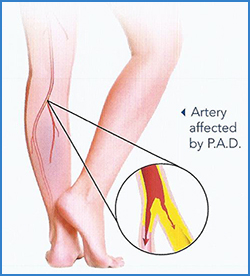What is P.A.D.?
P.A.D. is short for Peripheral Arterial Disease. People have P.A.D. when the arteries in their legs become narrowed or clogged with fatty deposits, or plaque (pronounced “plak”). The buildup of plaque causes the arteries to harden and narrow, which is called atherosclerosis (pronounced “ath-er-o-skler-o’-sis”). When leg arteries are hardened and clogged, blood flow to the legs and feet is reduced. Some people call this poor circulation.
 P.A.D. occurs most often in the arteries in the legs, but it also can affect other arteries that carry blood outside the heart. This includes arteries that go to the aorta, the brain, the arms, the kidneys and the stomach. When arteries that supply the heart are hardened or narrowed, it is called coronary artery disease or cardiovascular disease.
P.A.D. occurs most often in the arteries in the legs, but it also can affect other arteries that carry blood outside the heart. This includes arteries that go to the aorta, the brain, the arms, the kidneys and the stomach. When arteries that supply the heart are hardened or narrowed, it is called coronary artery disease or cardiovascular disease.
The good news is that like other diseases related to the arteries, P.A.D. can be treated by making lifestyle changes, by taking medicines, or by undergoing leg artery angioplasty or vascular surgery, if needed. And you can live well with P.A.D.
Is P.A.D. serious?
P.A.D. is a serious disease commonly affecting Americans over the age of 50. The hardened arteries found in people with P.A.D. are a sign that they are likely to have hardened and narrowed arteries to the heart and the brain. That is why people with P.A.D. have a two- to six-times greater chance of death from a heart attack or a stroke.
When the blood flow to the legs is greatly (or severely) reduced, people with P.A.D. may have pain when walking. P.A.D. may cause other problems that can lead to amputation of a toe, foot or a leg. People with P.A.D. may become disabled and not be able to go to work. As time goes on, they may have a very poor qualityof life.
Who is at risk for P.A.D.?
The chance of having P.A.D. increases as you get older. People over age 50 have a higher risk for P.A.D., but the risk is increased if you:
- Smoke, or used to smoke
- Have diabetes
- Have high blood pressure
- Have abnormal blood cholesterol levels
- Are of African American ethnicity
- Have had heart disease, a heart attack or a stroke
- Have a family history of P.A.D., heart attack or stroke.
What are the warning signs or symptoms of P.A.D.?
P.A.D.develops slowly over many years. In the early stages, most people with P.A.D. have no symptoms. Only about one out of four people with P.A.D. actually feel typical symptoms of P.A.D. in their leg muscles (known as “claudication”, defined below). By that time, their arteries may be so clogged or hardened that they are not getting enough oxygen to supply their leg muscles.
The most common signs of P.A.D. include one or more of these problems:
- Cramps, tiredness or pain in your legs, thighs or buttocks that always happens when you walk but that goes away when you rest. This is called claudication (pronounced “claw-di-kay ‘-shun”).
- Foot or toe pain at rest that often disturbs your sleep.
- Skin wounds or ulcers on your feet or toes that are slow to heal,or that do not heal.
Sometimes, people ignore their leg pain and think it is just a sign that they are getting older. As a result, many people with P.A.D. do not know they have it and do not get treatment. It is important to discuss any leg or thigh pain you may be having with your health care provider since it may be a warning sign of a serious disease such as P.A.D.
How do you test for P.A.D?
South Hills Foot and Ankle can provide you with PADnet Test. A PADnet test is a non-invasive diagnostic test that can provide early detection of P.A.D. The PADnet system detects blockages in arteries and the quality of blood flow using Pulse Volume Recordings (PVR) and segmental blood pressure measurements.
Before your test:
Getting ready for this test is simple. You will be asked to remove clothing that covers your arms and legs. A gown may be provided or you may bring shorts to wear. This test usually takes 15 to 20 minutes. Be sure to allow extra time to check in.
- Do not smoke or use tobacco for thirty minutes prior to your PADnet test . Smoking constricts the peripheral arteries and can interfere with the test.
- If you think you may not be able to tolerate lying flat on the exam table for the test, please tell your provider.
During your test:
While you lie on the exam table, pressure cuffs will be wrapped snugly around your arms, thighs, calves and ankles. The technician will inflate the cuffs, and sensors will record the PVR waveforms that correspond with your heartbeat. Blood pressures will be recorded at your arms and ankles. The Ankle-Brachia Index (ABI) is determined by the ratio between these pressures. You may be diagnosed with P.A.D. if your ankle pressure is lower than your arm pressure.
After your test:
You may return to your normal routine right after the test. Your doctor will let you know when the results are ready. If the ABI and/or waveforms are abnormal, your doctor may recommend additional diagnostic tests.

